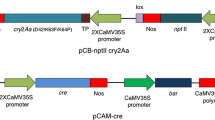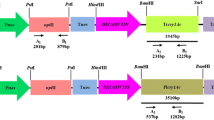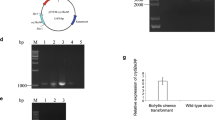Abstract
Transgenic crops expressing Cry δ-endotoxins of Bacillus thuringiensis for insect resistance have been commercialized worldwide with increased crop productivity and spectacular socioeconomic gains. To attain the enhanced level of protein expression, the cry genes have to be extensively modified for RNA stability and translation efficiency in the plant systems. However, such modifications in nucleotide sequences make it difficult to express the cry genes in Escherichia coli because of the presence of E. coli rare codons. Induction of gene expression through the T7 promoter/lac operator system results in high levels of transcription but limits the availability of activated tRNA corresponding to rare codons that leads to translation stalling at ribosomes. In the present study, an Isopropyl ß-D-1-thiogalactopyranoside (IPTG)/rifampicin combination-based approach was adopted to induce transcription of cry genes through T7 promoter/lac operator while simultaneously inhibiting the transcription of host genes through rifampicin. The results show that the IPTG/rifampicin combination leads to high-level expression of four plant codon-optimized cry genes (cry2Aa, cry1F, cry1Ac, and cry1AcF). Northern blot analysis of the cry gene expressing E. coli samples showed that the RNA expression level in the IPTG-induced samples was higher as compared to that in the IPTG/rifampicin-induced samples. Diet overlay insect bioassay of IPTG/rifampicin-induced Cry toxins with Helicoverpa armigera larvae showed bioactivity (measured as LC50) similar to the previous studies. The experiment has proved that recombinant synthetic gene (plant codon-optimized gene) with the combination of Rifampicin which inhibits DNA-dependent bacterial RNA polymerase and reduces the excessive baggage of translational machinery of the bacterial cell triggers the production of synthetic protein. Purification of protein using high pH buffer increases the solubility of the protein. Further, LC50 analysis shows no reduction of protein activity leads to protein stability. Further, purified cry toxin protein can be used for crop protection against pests and a purified form of the synthetic protein can be used for antibody production and perform the immunoassay for the identification of the transgenic plant. The crystallographic structure of synthetic protein could be used for interaction study with another insect to see insecticidal activity.





Similar content being viewed by others
Abbreviations
- IMAC:
-
Immobilized metal-affinity chromatography
- LB:
-
Luria–Bertani
- Cry:
-
Crystal
- IPTG:
-
Isopropyl–d-1-thiogalactopyranoside
- mAb:
-
Monoclonal antibody
- PVDF:
-
Polyvinylidene difluoride membrane
References
Bravo A, Gomez I, Porta H, Garcia-Gomez BI, Rodriguez-Almazan C, Pardo L, Soberon M (2013) Evolution of Bacillus thuringiensis Cry toxins insecticidal activity. Microb Biotechnol 6:17–26
Kumar PA, Sharma RP, Malik VS (1996) The insecticidal proteins of Bacillus thuringiensis. Adv Appl Microbiol 42:1–43
Schnepf E, Crickmore N, Van Rie J, Lereclus D, Baum J, Feitelson J, Zeigler DR (1998) Dean DH (1998) Bacillus thuringiensis and its pesticidal crystal proteins. Microbiol Mol Biol Rev 62:775–806
Strizhov N, Keller M, Koncz-Kalman Z, Regev A, Sneh B, Schell J, Koncz C, Zilberstein A (1996) Mapping of the entomocidal fragment of Spodoptera–specific Bacillus thuringiensis toxin Cry1C. Mol Gen Genet 253:11–19
Beegle CC, Yamamoto T (1992) History of Bacillus thuringiensis berliner research and development. Can Ent 124:587–616
de Maagd RA, Bravo A, Crickmore N (2001) How Bacillus thuringiensis has evolved specifictoxins to colonize the insect world. Trends Genet 17(4):193–199
Feitelson JS, Payne SJ, Kim L (1992) Bacillus thuringiensis: insects and beyond. Biotechnology 10:271–275
Pardo-Lopez L, Soberon M, Bravo A (2013) Bacillus thuringiensis insecticidal three–domain Cry toxins: mode of action, insect resistance and consequences for crop protection. FEMS Microb Rev 37(1):3–22
Pigott CR, Ellar DJ (2007) Role of receptors in Bacillus thuringiensis crystal toxin activity. Microbiol Mol Biol Rev 71(2):255–281
Bravo A, Likitvivatanavong S, Gill SS, Soberon M (2011) Bacillus thuringiensis: a story of a successful bio–insecticide. Insect Biochem Mol Biol 41:423–431
Knowles BH, Dow JAT (1993) The Crystal δ–endotoxins of Bacillus thuringiensis: models for their mechanism of action on the insect gut. Bio Essays 15:469–476
Knowles BH, Ellar DJ (1987) Colloid–osmotic lysis is a general feature of the mechanisms of action of Bacillus thuringiensis (delta)–endotoxins with different insect specificity. Biochem Biophys Acta 924:509–518
Raybould A, Quemada H (2010) Bt crops and food security in developing countries: realized benefits, sustainable use and lowering barriers to adoption. Food Secur 2(3):247–259
Diehn SH, De Rocher EJ, Green PJ (1996) Problems that can limit the expression of foreign genes in plants: lessons to be learned from Bt toxin genes. Springer, Berlin, pp 83–99
Perlak FJ, Fuchs RL, Dean DA, McPherson SL, Fischhoff DA (1991) Modification of the coding sequence enhances plant expression of insect control protein genes. Proc Natl Acad Sci USA 88(8):3324–3328
Song FS, Ni DH, Li H, Duan YB, Yang YC, Ni JL, Lu XZ, Wei PC, Li L, Yang JB (2014) A novel synthetic cry1Ab gene resists rice insect pests. Genet Mol Res 13:2394–2408
Khanna HK, Raina SK (2002) Elite indica transgenic rice plants expressing modified Cry1Ac endotoxin of Bacillus thuringiensis show enhanced resistance to yellow stem borer (Scirpophaga incertulas). Transgenic res 11(4):411–423
Chamberlin M, Ring J (1973) Characterization of T7–specific ribonucleic acid polymerase II. Inhibitors of the enzyme and their application to the study of the enzymatic reaction. J Biol Chem 248(6):2245–2250
Hartmann G, Honikel KO, Knusel F, Nuesch J (1967) The specific inhibition of the DNA directed RNA synthesis by rifamycin. Biochim Biophys Acta 145:843–844
Kuderova A, Nanak E, Truksa M, Brzobohaty B (1999) Use of rifampicin in T7 RNA polymerase–driven expression of a plant enzyme: rifampicin improves yield andassembly. Protein Expr Purif 16(3):405–409
Masters SB, Trevor AJ, Katzung BG (2005) Katzung & Trevor’s pharmacology. Lange Medical Books/McGraw Hill, Medical Pub., New York, p 123
Mouton Y, Deboscker Y, Dubreuil L, Thabaut A (1997) Antibiotiques, antiviraux, anti–infectieux. Les rifamycines. John Libbey Eurotext, Montrouge
Clarke TF, Clark PL (2008) Rare codons cluster. PLoS ONE 3(10):e3412
Kwon SK, Kim SK, Lee DH, Kim JF (2015) Comparative genomics and experimental evolution of Escherichia coli BL21 (DE3) strains reveal the landscape of toxicity escape from membrane protein overproduction. Sci Rep 5(1):1–13
Laemmli UK (1970) Cleavage of structural proteins during the assembly of the head of bacteriophage T4. Nature 227(5259):680–685
Bradford MM (1976) A rapid and sensitive method for the quantitation of microgram quantities of protein utilizing the principle of protein-dye binding. Anal Biochem 72:248–254
Padidam M (1992) The insecticidal crystal protein Cry1A(c) from Bacillus thuringiensis is highlytoxic for Heliothis armigera. J Invertbr Pathol 59:109–111
Finney DJ (1971) Probit analysis. Cambridge University Press, Cambridge
Hannig G, Makrides SC (1998) Strategies for optimizing heterologous protein expression in Escherichia coli. Trends Biotechnol 16(2):54–60
Kane J (1995) Effects of rare codon clusters on high–level expression of heterologous proteins in Escherichia coli. Curr Opin Biotechnol 6(5):494–500
Kurland C, Gallant J (1996) Errors of heterologous protein expression. Curr Opin Biotechnol 7(5):489–549
McNulty DE, Claffee BA, Huddleston MJ, Kane JF (2003) Mistranslational errors associated with the rare arginine codon CGG in Escherichia coli. Protein Expr Purif 27(2):365–374
Sorensen MA, Kurland CG, Pedersen S (1989) Codon usage determines translation rate in Escherichia coli. J Mol Biol 207(2):365–377
Zahn K (1996) Overexpression of an mRNA dependent on rare codons inhibits protein synthesis and cell growth. J Bacteriol 178:2926–2933
Labhesetwar P, Cole JA, Roberts E, Price ND, Luthey-Schulten ZA (2013) Heterogeneity in protein expression induces metabolic variability in a modeled Escherichia coli population. Proc Natl Acad Sci USA 110:14006–14011
Novick A, Weiner M (1957) Enzyme induction as an all or none phenomenon. Proc Natl Acad Sci USA 43:553–556
Raj A, van Oudenaarden A (2008) Nature, nurture, or chance; stochastic gene expression and its consequences. Cell 135:216–226
Gajendra Babu B, Udayasuriyan V, Asia Mariam M, Sivakumar NC, Bharathi M, Balasubramanian G (2002) Comparative toxicity of Cry1Ac and Cry2Aa delta-endotoxins of Bacillus thuringiensis against Helicoverpa armigera (H.). Crop Prot 21:817–822
Hernandez-Rodriguez CS, Hernandez-Martinez P, Van Rie J, Escriche B, Ferre J (2013) Sharedmidgut binding sites for Cry1A. 105, Cry1Aa, Cry1Ab, Cry1Ac and Cry1Fa proteins from Bacillus thuringiensis in two important corn pests, Ostrinia nubilalis and Spodoptera frugiperda. PLoS ONE 8(7):68164
Kumar S, Birah A, Chaudhary B, Burma PK, Gupta GP, Pental D (2005) Plant codon optimized cry genes of Bacillus thuringiensis can be expressed as soluble proteins in Escherichia coli BL21 Codon Plus strain as NusA-Cry protein fusions. J Invertebr Pathol 88(1):83–86
Liao C, Heckel DG, Akhurst R (2002) Toxicity of Bacillus thuringiensis insecticidal proteins for Helicoverpa armigera and Helicoverpa punctigera (Lepidoptera: Noctuidae), major pests of cotton. J Invertebr Pathol 80(1):55–63
Redwan EL (2006) The optimal gene sequence for optimal protein expression in Escherichia coli: principal requirements. Arab J Biotechnol 9:493–510
Acknowledgements
The authors thank ICAR-Network Project on Transgenic Crops for financial support and sincerely acknowledge all the institutions involved in this study.
Author information
Authors and Affiliations
Contributions
VKS, VN, MLVP, PAK designed the experiment; VKS performed most of the experiments, VN, MLVP, and SSC were involved in data analysis; SG performed the western blotting experiment; VKS, RS, KRSSR, PAK, and AK were involved in designing, manuscript editing and finalizing.
Corresponding authors
Ethics declarations
Conflict of interest
The authors declare that they have no conflict of interest.
Additional information
Publisher's Note
Springer Nature remains neutral with regard to jurisdictional claims in published maps and institutional affiliations.
Electronic supplementary material
Below is the link to the electronic supplementary material.
Rights and permissions
About this article
Cite this article
Singh, V.K., Nain, V., Phanindra, M.L.V. et al. Rifampicin Increases Expression of Plant Codon-Optimized Bacillus thuringiensis δ-Endotoxin Genes in Escherichia coli. Protein J 41, 327–336 (2022). https://doi.org/10.1007/s10930-022-10043-y
Accepted:
Published:
Issue Date:
DOI: https://doi.org/10.1007/s10930-022-10043-y




